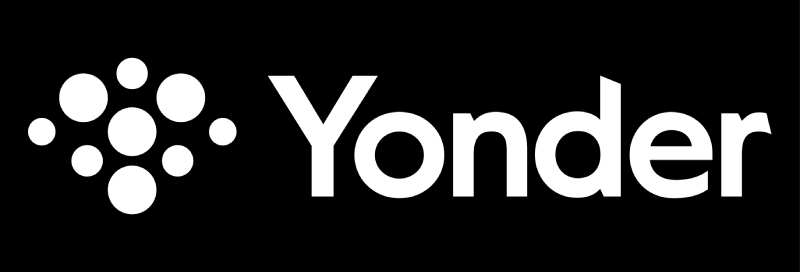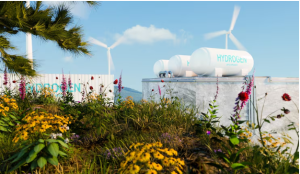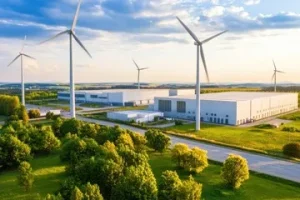DC-DC Converters: Powering the Future of Green Hydrogen Plants
What Powers the Heart of a Green Hydrogen Plant?
When people talk about the future of clean energy, green hydrogen is almost always part of the conversation. It’s clean, powerful, and versatile—ready to fuel everything from factories to fleets. But what many don’t realize is that behind every green hydrogen plant lies an unsung hero quietly doing the heavy lifting: the DC-DC converter.
At first glance, it may seem like just another piece of hardware in the electrical setup. But in reality, it’s one of the most critical components driving the efficiency, reliability, and success of hydrogen production. Whether you’re building a small pilot plant or scaling up to gigawatt capacity, how you manage and convert your power can make or break the system.
So, how exactly do DC-DC converters fit into the equation? Why are they so essential for powering electrolysers, especially when dealing with renewable sources like solar and wind? And what role do they play in helping green hydrogen live up to its clean energy promise?
Let’s break it down.
Why Green Hydrogen Plants Need DC-DC Converters
As global industries shift toward decarbonization, green hydrogen has emerged as a cornerstone of sustainable energy strategies. Unlike conventional hydrogen produced using fossil fuels, green hydrogen is generated through electrolysis, where water is split into hydrogen and oxygen using electricity, ideally sourced from renewables like wind or solar.
While the concept of electrolysis seems straightforward, the real challenge lies in efficiently managing the power supply to the electrolysers. And that’s where DC-DC converters step in as a critical power electronics component.
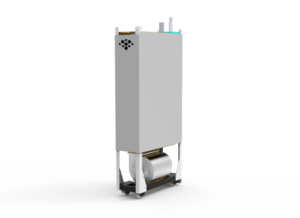
The Core Problem: Mismatched Power Inputs
Most renewable energy sources generate electricity in inconsistent and fluctuating ways:
Solar panels produce variable power depending on sunlight intensity.
Wind turbines’ output changes with wind speed and direction.
Hybrid energy systems may switch between AC and DC power depending on demand and supply conditions.
But electrolysers, the heart of hydrogen production, require stable and precisely controlled DC power to operate efficiently. They are sensitive to voltage fluctuations, irregular current inputs, and noise on the power line.
Feeding them raw power from renewables or the grid would:
Causes inefficiencies in the hydrogen production process
Increase thermal stress and wear on the electrolyser stack
Lead to higher maintenance costs and potential downtime
A DC-DC converter acts like a smart middleman that takes inconsistent or mismatched DC power and converts it into a clean, regulated DC supply that electrolysers can safely use.
Role of DC-DC Converters in a Green Hydrogen Plant
Let’s break it down in practical terms. In a typical green hydrogen plant setup:
Renewables like solar or wind generate electricity.
If the input is AC, it goes through a rectifier to become DC.
That DC power, which may still be unstable, is then routed through a DC-DC converter.
The converter adjusts the voltage and current to optimal levels based on the electrolyser’s needs.
The electrolyser splits water into hydrogen and oxygen.
Without that step (#3), the system becomes vulnerable to:
Overvoltage or undervoltage conditions
Power surges or sudden drops in output
Inefficient current delivery, which reduces hydrogen output per kWh
This is why DC-DC converters are not just optional—they are fundamental to the success and efficiency of green hydrogen production.
Benefits Specific to Green Hydrogen Applications
DC-DC converters offer a suite of advantages that align perfectly with the operational goals of hydrogen plants:
1. Voltage Regulation
Electrolysers operate at specific voltage thresholds. Even a slight deviation can drastically reduce hydrogen production efficiency. DC-DC converters maintain a constant output voltage, regardless of input fluctuations.
2. Current Control
Maintaining the right current density ensures the longevity of the electrolyser stack. Advanced converters offer programmable current limits, keeping systems safe and efficient.
3. Energy Efficiency
Modern converters achieve conversion efficiencies of 96–98%, ensuring that nearly all the input energy is used for electrolysis and not lost as heat.
4. Modularity and Scalability
DC-DC converters enable modular plant design, allowing operators to scale from kilowatts to megawatts by stacking or paralleling multiple units.
5. Dynamic Load Matching
Some electrolysers can adjust their operation based on available power. DC-DC converters make real-time adjustments to match the dynamic load profile, maximizing hydrogen output even under variable conditions.
6. Electrolyser Protection
Unregulated power can overheat or degrade an electrolyser. A converter acts as a protective barrier, delivering clean power and extending the service life of key components.
Without DC-DC Converters, What Goes Wrong?
Let’s imagine a hydrogen plant running directly from solar without a converter:
On a cloudy day, voltage drops below the threshold needed for efficient water splitting. The plant continues running but produces less hydrogen per watt, reducing output.
During peak sunlight, voltage spikes above safe limits, causing excessive heat buildup in the electrolyser, leading to wear and premature failure.
If the plant connects directly to the grid, any transient spikes or sags can trigger faults or shutdowns, causing unplanned downtime.
All of this can be avoided with the intelligent regulation provided by a well-designed DC-DC converter.
Industry Insight: Power Electronics Is the New Bottleneck
In many green hydrogen projects, stakeholders focus heavily on the electrolysis technology itself—whether it’s PEM, alkaline, or SOEC. But the power supply chain is just as important.
According to a recent report by IRENA (International Renewable Energy Agency), power electronics—especially DC-DC converters—are among the top factors influencing efficiency and cost in green hydrogen production. The right converter design can significantly lower the levelized cost of hydrogen (LCOH), making the technology commercially viable.
YonderH2: Engineering Excellence in Converter Design
At YonderH2, we understand these demands deeply. Our DC-DC converters are built to handle:
High currents and voltage ratings required by industrial-scale electrolysers
Fast response times to match renewable variability
Harsh environmental conditions, from desert solar farms to offshore wind setups
We don’t just provide hardware—we engineer complete power management solutions tailored for the unique needs of green hydrogen systems.
Green hydrogen plants need DC-DC converters because:
Electrolysers require steady, optimized DC power
Renewable energy sources are inherently variable
DC-DC converters ensure efficiency, safety, and reliability
They make scaling and smart integration possible
Without them, green hydrogen wouldn’t just be harder to produce—it would be less efficient, more expensive, and less scalable.
The Power Challenge: Unstable Input, Precision Required
When designing a green hydrogen plant, one of the biggest hurdles isn’t just the electrolyser—it’s the power input. Most people think that once you hook up solar panels or a wind turbine, you’re good to go. But in reality, the quality, stability, and precision of that power determine whether your electrolyser operates efficiently… or fails spectacularly.
Let’s dig into why.
Renewable Energy Is Powerful—But Not Predictable
Green hydrogen is almost always tied to renewable sources. Why? Because the whole point is to create zero-emission fuel using clean electricity. But here’s the catch:
Solar power changes every minute with cloud cover, sun angle, or dust on panels.
Wind energy fluctuates even faster, gusty, irregular, and seasonally dependent.
Hybrid systems might switch between sources or even rely on backup grid power during lulls.
This means the electrical input to your hydrogen system is anything but steady.
Now, imagine sending this fluctuating power directly to your electrolyser stack.
The electrolyser might start and stop repeatedly, reducing its lifespan.
Power dips cause partial hydrogen production, reducing efficiency.
Voltage spikes might overheat or damage sensitive components.
In short, unstable input = unstable output = increased cost and lower reliability.
Electrolysers Crave Precision
Here’s something many newcomers overlook: Electrolysers are precision machines. Whether it’s an alkaline or PEM type, these systems are designed to operate within very specific voltage and current parameters.
Let’s say your PEM electrolyser operates optimally at 400V and 500A.
If you send 350V, it might still run, but the hydrogen output drops, and the stack efficiency plummets.
If it gets 500V, internal temperatures rise, the membrane degrades faster, and you risk permanent damage.
This isn’t just a minor technicality—it’s a core operational requirement.
To keep electrolysers in their sweet spot, you need:
Stable DC voltage output
Tightly controlled current
Real-time response to changing load and power conditions
Which brings us back to the solution…
DC-DC Converters: The Precision Enablers
Think of a DC-DC converter as a translator. It takes the raw, chaotic power from renewable sources and transforms it into a clean, tailored power supply that your electrolyser can actually use.
Specifically, they help solve this challenge by:
Converting wide-range DC inputs (e.g., from 250V to 750V) into a stable output (e.g., a constant 400V)
Smoothing out voltage spikes and dips
Regulating current flow to avoid thermal runaway or stack degradation
Providing soft-start and ramp-up features, reducing inrush current damage
Without a converter in the middle, you’re essentially throwing raw fuel at a high-performance engine and hoping it doesn’t knock or explode.
Real-World Scenarios
Here’s how this plays out in practice:
Scenario A: A Cloudy Solar Farm in Rajasthan
A large green hydrogen plant is powered by a 50 MW solar array. As clouds pass, output drops momentarily from 100% to 60%. Without a converter:
Voltage drops hit the electrolyser stack.
Hydrogen production dips.
The system operates below optimal efficiency for several minutes.
With a converter:
The output voltage remains steady.
Electrolyser performance stays consistent.
No production loss, no added stress.
Scenario B: Wind-Powered Electrolysis in Scotland
Wind speed fluctuates every few seconds. Raw DC from the wind turbines ranges from 200V to 700V.
A DC-DC converter steps this variable voltage into a consistent 450V for the PEM stack.
It dynamically adjusts in real-time, avoiding overvoltage and current spikes.
What Happens Without Precision?
Let’s be blunt—your entire hydrogen system becomes vulnerable:
Stack degradation: More downtime, more replacement cost
Increased thermal stress: Higher cooling demands
Unstable production: Less hydrogen per kWh of input
Low efficiency: Higher cost per kg of hydrogen
This directly impacts the Levelized Cost of Hydrogen (LCOH), a key metric in making green hydrogen commercially viable. If your power input isn’t stable, your hydrogen becomes more expensive—and less competitive.
Precision Power = Scalable Green Hydrogen
The green hydrogen industry is aiming for scale, massive, gigawatt-scale projects across the globe. And precision becomes non-negotiable at that level.
DC-DC converters ensure that:
Your electrolysers get exactly the power they need
You can scale modularly without electrical chaos
Your system remains resilient to real-world renewable conditions
As green hydrogen becomes part of national energy policies, the demand for robust, efficient power control solutions will skyrocket. And DC-DC converters will be right at the heart of it.
Inside a DC-DC Converter: Components and Functionality
So we’ve talked about why green hydrogen plants need DC-DC converters—but what actually goes on inside these silent power architects? It’s not just a matter of plugging in and watching magic happen. DC-DC converters are highly engineered systems built to transform, regulate, and protect power as it flows toward your electrolyser.
Let’s pop the hood and take a closer look.
It’s Not Just a Box—It’s an Intelligent Power Manager
At its core, a DC-DC converter is designed to do one simple thing: convert one level of DC voltage to another. But the real challenge lies in doing this with speed, precision, and efficiency—even when input power is bouncing all over the place.
These converters often handle hundreds or thousands of kilowatts in large-scale green hydrogen plants. That means they must:
Scale safely and efficiently
Operate 24/7 under variable conditions
Communicate with other systems (like transformers, rectifiers, and control software)
To accomplish this, DC-DC converters are made up of several key components, each with a specific job.
Key Components of a DC-DC Converter (And What They Do)
1. Input Filter
Before anything gets converted, the power input must be cleaned. The input filter blocks unwanted electrical noise or harmonics from renewable sources or upstream equipment.
🔹 Why it matters: Electrolysers are sensitive to ripple and noise, which can degrade performance over time.
2. Switching Device (Typically IGBT or MOSFET)
This is the heart of the converter. Using high-speed switching, the IGBT (Insulated-Gate Bipolar Transistor) or MOSFET rapidly turns the input voltage on and off at high frequencies—usually several kilohertz.
🔹 Why it matters: This switching action allows voltage transformation to happen in a compact, efficient way, and it determines how precise the output will be.
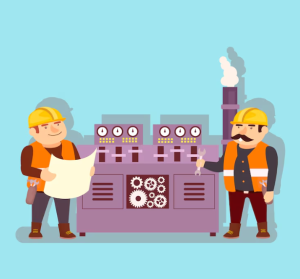
At YonderH2, we specialize in converters with IGBT modules, known for handling large power loads with minimal energy loss, perfect for high-throughput electrolysis applications.
3. Transformer (in Isolated DC-DC Converters)
If isolation is needed (which is often the case in hydrogen plants), the switched power is passed through a high-frequency transformer to isolate the input and output sides electrically.
🔹 Why it matters: Safety. This protects your electrolyser and human operators from back-feed or voltage spikes.
4. Output Rectifier and Filter
Once transformed, the power is still pulsating DC. A rectifier and filter smooth it into a pure, stable DC output, perfect for your electrolyser’s needs.
🔹 Why it matters: Consistency. Hydrogen production relies on a predictable DC voltage and current.
5. Control System (Digital Controller or DSP)
This is where intelligence comes in. A digital control system constantly monitors input voltage, output demand, and temperature, then adjusts the switching behavior in real-time.
🔹 Why it matters: It ensures that the converter adapts dynamically—even second-by-second—to changing energy input from solar or wind.
Efficiency Matters: Heat and Losses
No conversion system is 100% efficient. Even the best DC-DC converters lose a small percentage of power as heat, usually 2% to 5% depending on size and design.
That’s why these converters often include:
Cooling systems (air-cooled or liquid-cooled)
Thermal sensors and fans
Over-temperature protection mechanisms
In large-scale plants, even a 3% loss on a 10 MW input means 300 kW of heat to manage. So smart thermal design is critical—not just for converter longevity, but also for plant efficiency.
Advanced Features You’ll Find in Modern Converters
High-performance converters for green hydrogen plants don’t just stop at voltage convearsion. Many now come with advanced monitoring and diagnostic capabilities, including:
Remote telemetry and SCADA integration
Load-sharing features for modular electrolyser stacks
Self-diagnostics for predictive maintenance
Harmonic reduction for grid compliance
This turns the converter from a passive component into a smart energy manager, giving you more control over how, when, and where your hydrogen is produced.
Modular vs Centralized Converters: What’s Better?
There’s an ongoing debate in the green hydrogen space: Should you go with one large central converter, or several smaller modular ones?
Modular Converters:
Allow flexibility in scaling
Are easier to maintain (replace just one if it fails)
Help in stack-by-stack control for distributed electrolysers
Central Converters:
Offer lower initial cost
Have fewer parts and cables
Are ideal for plants with unified, centralized electrolysis stacks
At YonderH2, we tailor our power systems based on your plant size, electrolyser type, and input energy variability, offering both centralized and modular DC-DC solutions.
Functionality Summary: What the DC-DC Converter Does for You
Let’s wrap this section with a quick recap of what your converter actually does on a day-to-day basis in a green hydrogen plant:
Function | What It Solves |
Converts Variable DC | Matches renewable output to electrolyser needs |
Regulates Voltage | Keeps stack performance optimal and safe |
Isolates Circuits | Prevents faults from spreading |
Reduces Noise | Protects sensitive control electronics |
Manages Heat | Prevents damage and extends lifespan |
Enables Control | Gives operators full visibility and remote access |
DC-DC converters might sit quietly in a control room or substation, but their work is critical, as vital to green hydrogen as the electrolyser itself. Without them, everything from efficiency to safety to hydrogen purity is compromised.
Next up, we’ll dive into how these converters enable scalability and modularity, making them essential for today’s gigawatt-scale green hydrogen ambitions.
Enabling Scalability and Modularity in Green Hydrogen Plants
When we talk about building the green hydrogen economy, we’re not thinking small. We’re talking megawatt and even gigawatt-scale plants capable of producing tons of clean hydrogen every day. But here’s the big question: how do you scale a green hydrogen plant without losing efficiency, safety, or control?
The answer? DC-DC converters—not just as power regulators but as the backbone of scalable, modular green hydrogen infrastructure.
Modularity: Building Block by Block
Green hydrogen production isn’t always a “one-size-fits-all” setup. Electrolysers are often arranged in modules or stacks, each requiring individual control, monitoring, and power conditioning. This is where modular DC-DC converter architecture shines.
Why modularity matters:
Allows you to start small and scale fast
Easy integration with new electrolyser stacks
Enables independent control of each unit
Reduces downtime during maintenance
Supports redundancy—so if one module fails, the rest keep running
Each DC-DC converter in this setup acts like a dedicated power supply to a single electrolyser unit, ensuring maximum flexibility and minimal risk.
Scalability: Growing Without Limits
Whether you’re a startup pilot plant or scaling up to a multi-MW facility, DC-DC converters make it possible to:
Match power delivery with growing production demands
Adapt to changing renewable energy profiles
Plug-and-play with new electrolyser stacks
Stay efficient across different load levels
Let’s say your plant starts with 10 MW of solar input and plans to scale to 100 MW over 5 years. With scalable DC-DC systems, you don’t need to rebuild your entire infrastructure. Just add new converter modules as needed and expand seamlessly.
How DC-DC Converters Enable Modular Electrolyser Control
Each electrolyser stack has its own operating voltage and current range. Without independent converters, power control becomes messy, inefficient, and sometimes dangerous.
DC-DC converters give you:
Fine-grained voltage control for each stack
Real-time current tuning for optimal hydrogen output
Load balancing to distribute power across multiple stacks
Think of it like this: instead of pouring all your energy into one bucket, you’re delivering the exact right amount of energy to each cup, on-demand, in real-time.
Real-World Example: Scalable Hydrogen with Modular DC-DC Design
Take a hypothetical green hydrogen plant using alkaline electrolysers across 20 modular stacks. Each requires:
1000 V DC
1000 A current
With a modular DC-DC design, each electrolyser stack gets its own 1 MW converter. If one unit goes offline for maintenance, the other 19 keep producing hydrogen. That’s built-in redundancy—critical for maintaining uptime in large-scale hydrogen production.
At YonderH2, we design scalable DC-DC systems tailored to your plant’s growth trajectory, so you can expand without starting over.
The Bigger Picture: Modular Design Supports the Hydrogen Ecosystem
Green hydrogen isn’t just about electrolysis. It’s about integration—with:
Energy storage systems
Smart grids
Fuel cell systems
Oxygen recovery and reuse systems
DC-DC converters serve as the link between these systems, enabling modular plug-and-play configurations across your entire hydrogen value chain. That means less downtime, faster deployment, and greater ROI.
Cost Efficiency: Why Modular DC-DC Systems Make Business Sense
A lot of project developers ask: Isn’t modular more expensive? Not necessarily. Here’s how DC-DC converters drive down long-term costs:
Benefit | Financial Impact |
On-demand scalability | CapEx optimized over time |
Lower maintenance | Reduced OpEx from modular replacement |
Less downtime | Higher hydrogen output per year |
Smart load control | Lower energy waste, lower bills |
Integrated telemetry | Fewer manual checks, better automation |
When your DC-DC system grows with you, your plant becomes future-ready without the future cost burden.
Modular + Smart = The Future of Green Hydrogen
As the industry shifts toward digital twins, AI-based plant management, and autonomous operations, DC-DC converters will play an even bigger role. They’re no longer just passive devices—they’re intelligent, modular, networked tools that adapt and evolve with your green hydrogen operation.
Whether you’re powering a single PEM electrolyser or building the next gigafactory, DC-DC converters enable the scale, precision, and control that modern green hydrogen plants demand.
Design Considerations for DC-DC Converters in Hydrogen Applications
Designing a green hydrogen plant isn’t just about plugging in electrolysers and watching hydrogen bubble up. It’s about orchestrating a highly tuned power system where every volt and amp is optimized for performance, safety, and longevity. At the core of that orchestration? The DC-DC converter—and it needs to be designed right.
Whether you’re working with PEM (Proton Exchange Membrane) or alkaline electrolysis, choosing and configuring the right DC-DC converter means balancing electrical, thermal, and control challenges to get the most out of every electron.
Voltage and Current Requirements
Electrolyzers don’t run on a universal setting—they each have their own operating voltage and current requirements. That means your DC-DC converter needs to precisely match the stack characteristics.
Typical requirements:
PEM electrolysers: 200–1000 V DC at 500–3000 A
Alkaline electrolysers: Often higher current, broader voltage range
So, the converter must provide:
Wide input/output voltage range
Accurate current regulation
Fast response time to load fluctuations
Using the wrong converter? You could end up with low efficiency, overheating, or stack damage.
Thermal Management
High-current DC systems generate serious heat. If not managed, it can damage not just the converter but also the electrolyser stack and surrounding components. That’s why thermal management is non-negotiable.
Design options include:
Liquid-cooled heat sinks for high-density installations
Forced-air cooling for lower-power modules
Integrated thermal monitoring for predictive shutdown and alerts
In green hydrogen plants, where uptime is everything, a thermal event = a production halt. Smart DC-DC designs prevent that risk before it starts.
Safety and Redundancy
You’re dealing with thousands of volts and amps. Safety isn’t optional—it’s fundamental. Good DC-DC converters are engineered with multiple layers of protection.
Must-have safety features:
Overvoltage and undervoltage protection
Short-circuit handling
Reverse polarity safeguards
Isolated input/output for grid safety
EMC filtering to prevent interference with control systems
And because hydrogen plants often operate in remote or high-risk zones, redundancy is critical:
Dual-redundant converter paths
Hot-swappable converter modules
Fault-tolerant power bus systems
If one module fails, the system must continue without downtime—safety and continuity in one design.
Bidirectional Capabilities (If Needed)
Some setups—especially where hydrogen is being stored and reconverted (e.g., via fuel cells or for grid balancing)—require bidirectional power conversion. That means your converter not only powers the electrolyser but also accepts power back from energy storage systems.
This is common in:
Smart grid-integrated hydrogen systems
Battery-buffered electrolyser designs
Hybrid solar-hydrogen-fuel cell plants
Bidirectional DC-DC converters allow for dynamic energy routing, adapting to where the power is needed most.
Grid Compatibility and Input Conditioning
Many green hydrogen plants pull power directly from solar, wind, or hybrid grids, which can be unstable or variable. The converter must be able to:
Accept variable DC from PV panels or battery banks
Handle AC-DC rectified power from the grid
Clean and stabilize the input power
Modern DC-DC converters often include:
MPPT (Maximum Power Point Tracking) for solar inputs
DC bus stabilization
Integrated filtering for ripple reduction
This makes your hydrogen production more resilient to real-world energy fluctuations—a must in renewables-dominated ecosystems.
Digital Control and Monitoring
Old-school converters were black boxes. Today’s DC-DC converters are smart, digital, and connected—designed for:
Remote diagnostics
Predictive maintenance
Load tuning via SCADA or HMI
Real-time alerts via IIoT platforms
At YonderH2, our systems come with fully integrated telemetry for live monitoring, historical data logging, and automated alerts.
With smart diagnostics, you don’t just react to faults—you anticipate them.
Custom vs. Standard Designs: What Should You Choose?
Not all green hydrogen plants are created equal. Some need off-the-shelf reliability; others require custom-engineered solutions.
Requirement | Standard Converter | Custom Converter |
Faster deployment | ✅ | ⚠️ (longer lead time) |
High-volume manufacturing | ✅ | ⚠️ |
Electrolyser-specific tuning | ⚠️ | ✅ |
Multi-mode operation (e.g. storage + fuel cell) | ⚠️ | ✅ |
Complex safety/redundancy needs | ⚠️ | ✅ |
YonderH2 helps you balance speed, cost, and customization to get the right fit for your plant’s design and operational goals.
Pro Tip: Future-Proof with Modular and Upgradable Designs
As your hydrogen plant evolves, your power systems should evolve with it. That’s why modern DC-DC converter design now includes:
Modular plug-in units
Firmware upgrades
Field-replaceable parts
Expandable voltage and current range
Why rip and replace when you can adapt and extend?
Types of DC-DC Converters Used in Electrolyser Systems
Not all DC-DC converters are created equal, and in a green hydrogen plant, choosing the right topology can make or break your system’s efficiency, cost, and control. Think of these converters like specialized tools in a high-stakes energy workshop—each designed for a particular job. Here’s how they stack up.
Buck Converters (Step-Down)
These are the workhorses of many hydrogen systems. Buck converters reduce a higher input voltage to a lower output voltage, perfect for applications where the power source (like a PV array or rectifier) delivers more voltage than the electrolyser stack needs.
Where they’re used:
When feeding lower-voltage PEM stacks from a high-voltage DC bus
Solar-powered setups where the panel voltage exceeds the electrolyser limits
Benefits:
Simple design
High efficiency (up to 95%)
Compact size
Watch-out:
Limited voltage range
Not ideal for bidirectional power flow
Boost Converters (Step-Up)
Got a DC source that’s not quite hitting your electrolyser’s voltage requirements? Enter the boost converter—it takes a lower voltage and steps it up.
Common in:
Battery-buffered systems
Hybrid solar-battery electrolysis
Low-voltage microgrids
Benefits:
Small and lightweight
Good for intermittent/low-voltage sources
Challenges:
Increased voltage stress on components
Lower efficiency under heavy loads
Buck-Boost Converters (Flexible Voltage Control)
Need both step-up and step-down in one converter? Buck-boost topologies offer that flexibility, especially valuable when your input voltage fluctuates (as it often does with solar or mixed-grid inputs).
Perfect for:
Plants using mixed renewable inputs
Mobile hydrogen production skids
Variable load operations
Why they’re great:
Wide dynamic range
Fewer control interruptions
Ideal for off-grid, autonomous systems
Isolated Converters (Flyback, Forward, Push-Pull)
When electrical isolation between the source and load is critical, isolated DC-DC converters come into play. These are essential in setups where safety, noise immunity, or dual-grounded systems are involved.
Types include:
Flyback (simpler, lower power)
Forward (higher efficiency for medium power)
Push-pull or full-bridge (for high power, multi-kW systems)
Why go isolated?
Grid-tied systems with potential voltage surges
Safety in floating or hazardous environments
EMI-sensitive industrial zones
Downside?
More complex
Typically higher cost and larger footprint
Bidirectional DC-DC Converters
These aren’t just fancy—they’re crucial for smart hydrogen systems that combine:
Energy storage (e.g., battery banks)
Fuel cells for backup or grid feedback
Load balancing across DC buses
Applications:
Load shifting between electrolysis and battery charging
Feeding excess renewable power to the grid through hydrogen
Decentralized microgrids with hydrogen and storage buffers
These converters allow power to flow both ways, intelligently managed based on demand, pricing, or carbon intensity. In short, they’re essential for grid-interactive hydrogen production.
Modular Converters
Many modern plants now use modular DC-DC converter blocks that can be connected in series or parallel to scale up/down as needed. These allow:
Hot-swapping units without downtime
Smart fault isolation
On-demand capacity expansion
Think of them as Lego blocks for power engineering—perfect for scaling with demand.
How to Choose the Right Converter?
Converter Type | Ideal For | Limitations |
Buck | High → low voltage supply | Fixed ratio |
Boost | Low → high voltage source | Lower efficiency |
Buck-Boost | Variable voltage systems | Complex control |
Isolated | Safety and EMI protection | Higher cost |
Bidirectional | Energy storage or smart grid | More complex integration |
Modular | Scalability & uptime | May need advanced controls |
Pro Insight from YonderH2:
We design hybrid systems using a mix of converter topologies tailored to:
Electrolyser type (PEM, alkaline, SOEC)
Energy source (grid, solar, wind, battery)
Hydrogen demand profile (peak/off-peak)
Safety and redundancy targets
You don’t need one converter—you need the right mix, working in harmony.
DC-DC Converter Efficiency in Green Hydrogen Plants: Why Every Percent Matters
When it comes to powering a green hydrogen plant, energy efficiency isn’t just a technical metric—it’s the bottom line. In a process where you’re already investing heavily in renewable energy infrastructure, electrolysis stacks, water purification systems, and more, even a small gain in conversion efficiency can lead to huge operational savings.
And that’s where the DC-DC converter steps in as a silent—but essential—efficiency champion.
Why Efficiency Is So Critical
Let’s say your electrolyser requires 500V DC input to run optimally. If your power source is delivering 700V or 400V—or worse, fluctuating between the two—you’ll need a converter to stabilize that. But every time power is converted, some of it is lost as heat.
Now scale that loss across:
Megawatts of renewable power,
24/7 operating hours,
Over 20+ years of plant life…
You could be talking millions of dollars in lost energy if your conversion system isn’t optimized.
That’s why high-efficiency converters (typically >95%) are a must—not a luxury—for green hydrogen operations.
Where Energy Losses Happen in DC-DC Converters
Even the best converters have loss points. Here’s where those energy gremlins usually lurk:
Switching losses: Transistors lose energy during on/off cycles
Conduction losses: Resistance in wires and components wastes power as heat
Magnetic losses: Transformers and inductors aren’t perfect, especially under high load
Control losses: Some energy is used just to run the converter’s control system
These losses are small in isolation, but compound quickly in large-scale systems.
Smart Converter Design = Higher Efficiency
To combat losses, modern green hydrogen plants are now deploying advanced converter designs with features like:
Soft switching (ZVS/ZCS): Reduces switching losses
Synchronous rectification: Minimizes conduction losses
Multiphase interleaving: Balances load across multiple circuits to reduce stress
Wide bandgap semiconductors (SiC, GaN): Allow faster, cooler, more efficient switching
These aren’t just buzzwords—they’re technologies that improve system yield, reduce cooling requirements, and extend the life of your equipment.
Dynamic Efficiency in Variable Load Conditions
Here’s a real-world challenge: Renewable power isn’t constant. Solar and wind output fluctuates. But electrolysers need steady power, or at least predictable power. DC-DC converters bridge that gap.
A top-performing converter:
Maintains peak efficiency across a range of loads (partial or full)
Supports MPPT (Maximum Power Point Tracking) when integrated with solar
Reacts in milliseconds to changes in load or input supply
This is crucial for plants operating in islanded microgrids or relying heavily on renewables.
YonderH2’s Efficiency-Driven Engineering
At YonderH2, our approach to DC-DC converters is simple: optimize every watt. We focus on:
Tailoring converter topologies for specific electrolyser loads
Incorporating real-time thermal management to reduce heat waste
Using modular designs that avoid oversizing (which often leads to poor part-load efficiency)
Efficiency isn’t a bonus—it’s designed in.
Quick Example: What 2% Efficiency Loss Looks Like
Let’s do the math:
Power input: 10 MW
Electrolyser voltage requirement: 600V
DC-DC efficiency: 95% vs. 97%
That 2% difference = 200 kW of power lost
Over 1 year (assuming 8000 operating hours) = 1.6 GWh lost
Cost at $0.08/kWh = $128,000/year
And that’s just from a single efficiency point.
Bottom line? If your green hydrogen plant is the orchestra, the DC-DC converter is the conductor, fine-tuning every note to ensure optimal harmony between power supply and hydrogen output.
Thermal Management and Reliability of DC-DC Converters in Green Hydrogen Applications
If there’s one thing engineers and plant operators can agree on, it’s this: heat is the enemy of efficiency and reliability. Especially in high-power environments like green hydrogen plants, where DC-DC converters are expected to run for thousands of hours with minimal downtime, thermal management becomes mission-critical.
Let’s unpack why keeping converters cool isn’t just a comfort issue—it’s about protecting your investment, your uptime, and ultimately, your hydrogen output.
Why Do DC-DC Converters Generate So Much Heat?
Even the most efficient converter loses a few percent of power as heat. In systems handling megawatts of current, those few percent translate into kilowatts of thermal energy.
Here’s what contributes to heat buildup:
High-frequency switching
Power transistor losses (IGBTs, MOSFETs)
Transformer core saturation
Inductor/capacitor dissipation
Parasitic losses across connections and PCB traces
Now imagine that heat trapped inside a sealed converter enclosure, running 24/7. Without proper cooling, your components age faster, switch slower, and fail sooner.
How Do Modern DC-DC Converters Handle Thermal Stress?
There are typically three levels of thermal management strategies used in green hydrogen plant converters:
Passive cooling (heat sinks + convection): Cost-effective but limited. Works for smaller systems.
Active air cooling (fans and ducting): Common for mid-range converters. Requires regular maintenance.
Liquid cooling systems (cold plates, glycol loops): Ideal for high-density, high-power converters in hydrogen plants. Efficient, quiet, and scalable.
Bonus: Liquid cooling often enables more compact converter designs, which is key when space is limited in containerized hydrogen units or offshore platforms.
Smart Thermal Monitoring = Early Failure Prevention
YonderH2’s converters are equipped with:
Embedded thermal sensors at critical hotspots (switches, inductors, capacitors)
Real-time thermal telemetry to your plant’s control room
Predictive maintenance triggers when temperatures drift beyond baseline norms
Why does this matter? Because thermal fatigue is a slow killer—it wears down solder joints, degrades insulation, and silently undermines system stability until… boom. Unplanned downtime.
The Link Between Thermal Management and Long-Term Reliability
Think of your DC-DC converter like a marathon runner. If it’s constantly running hot, it won’t last the race. But if it’s cooled, rested, and optimized, it can go the distance—20+ years in some cases, with minimal intervention.
Here’s how better thermal management translates to real-world reliability:
Less thermal cycling stress = fewer component failures
Stable operation across temperature extremes = wider deployment range
Improved MTBF (Mean Time Between Failures)
Lower maintenance costs over the lifecycle
This is especially vital for remote hydrogen plants, where repair logistics are complex and downtime is expensive.
Case in Point: Harsh Environments Demand Tougher Converters
From the scorching deserts of the Middle East to the icy plains of northern Europe, green hydrogen plants are being deployed in extreme climates. That’s why YonderH2 designs converters with:
Extended operating temp ranges (-40°C to +70°C)
IP-rated enclosures to block dust, humidity, salt, and vapors
Conformal coatings and rugged components
Reliability isn’t just an engineering goal—it’s a survival trait in the hydrogen economy.
YonderH2’s Approach to Converter Longevity
We don’t just test our converters under ideal lab conditions—we stress test them in real-world scenarios. Each YonderH2 unit is subjected to:
Thermal shock tests
High-humidity operation simulations
Load cycle fatigue testing
Why? Because our clients can’t afford surprise failures. Their green hydrogen output depends on us staying cool, literally.
In short, A DC-DC converter’s performance is only as good as its temperature profile. Managing heat is not an afterthought—it’s a design priority. Because the hotter your converter runs, the shorter it lives. And the more it cools efficiently, the longer your green hydrogen plant thrives.
Types of DC-DC Converter Topologies Used in Green Hydrogen Plants
Not all DC-DC converters are created equal, and in the world of green hydrogen, choosing the right topology is about more than just voltage transformation. It’s about efficiency, scalability, responsiveness to renewables, and how well your converter handles dynamic loads like water electrolysers.
Let’s walk through the most relevant converter topologies and understand where each fits in the hydrogen ecosystem.
Buck Converters (Step-Down)
What it does: Reduces voltage from a higher input (e.g., solar array) to a lower output suitable for electrolysers or intermediate storage systems.
Why it matters for hydrogen:
Electrolysers have optimal voltage ranges; too high, and you risk damage.
Buck converters allow you to safely regulate power from variable renewable sources.
Use case: When solar panels feed higher voltage than the electrolyser needs (e.g., 1000V DC to 600V DC).
Boost Converters (Step-Up)
What it does: Increases voltage from a lower DC input to a higher output level.
In green hydrogen plants:
You may need to boost voltage from battery banks or low-voltage PV strings to drive electrolysers or charge intermediate DC buses.
Boosting ensures the system reaches electrolysis activation thresholds even under low input conditions.
Use case: Feeding electrolyser stacks during early morning or cloudy periods when solar voltage is insufficient.
Buck-Boost Converters (Bidirectional Voltage Control)
What it does: Offers both step-up and step-down functionality, depending on input/output conditions.
Why it’s perfect for green hydrogen systems:
Renewable inputs (wind, solar) fluctuate constantly.
Buck-boost converters automatically adjust to ensure consistent voltage output, protecting electrolyser life.
Use case: Variable load and supply situations where input voltage may swing above or below the target output.
Isolated Converters (Using Transformers)
What it does: Electrically isolates input and output sides, often with high-frequency transformers.FFF
Crucial in hydrogen plants because:
Safety is non-negotiable. Isolation prevents DC faults from propagating.
Isolated topologies like Full-Bridge, Half-Bridge, or Push-Pull provide high power with minimal EMI.
Use case: Industrial-scale hydrogen production where grounding, fault tolerance, and operator safety are key.
Multiphase Interleaved Converters
What it does: Uses multiple converter phases to split the power load.
Why it’s game-changing:
Shares thermal load across phases, reducing stress per component
Minimizes current ripple, improving electrolyser stability
Enhances fault tolerance—if one phase fails, others keep the system running
Use case: Megawatt-scale green hydrogen plants needing high-current, low-noise power conversion.
Choosing the Right Topology: What to Consider
When selecting the ideal converter for your plant, engineers weigh several factors:
Input source: solar, wind, grid, or hybrid?
Load type: PEM electrolyser, alkaline electrolyser, or battery?
Voltage levels and current demands
Space, cooling, and enclosure requirements
Isolation needs for operator and equipment safety
At YonderH2, our engineers don’t believe in a one-size-fits-all solution. Every hydrogen plant is unique. That’s why we custom-configure our converters to match the project’s voltage window, power capacity, environmental conditions, and redundancy requirements.
Real-World Insight
In one of our European installations, where wind turbines fed a PEM electrolyser, we used a dual interleaved buck-boost isolated topology—providing seamless voltage regulation across wind gusts, maintaining optimal hydrogen flow, and reducing energy waste by over 7% compared to the client’s previous converter setup.
So, when it comes to DC-DC converters, topology isn’t just a technical term—it’s the architectural blueprint that powers your plant’s performance. Pick the right one, and your hydrogen production stays clean, stable, and scalable.
Efficiency, Loss Reduction & Power Quality in Hydrogen Converter Systems
In green hydrogen plants, energy efficiency isn’t a luxury—it’s the heartbeat of your profitability and sustainability. The cleaner and more efficiently we convert energy, the more cost-competitive green hydrogen becomes compared to grey or blue alternatives.
Why Efficiency Matters in Hydrogen Economics
Let’s break it down:
Green hydrogen production via water electrolysis is already energy-intensive.
Every 1% loss in power conversion means higher operational costs and lower hydrogen output per kWh.
In megawatt-scale operations, even a 2–3% efficiency gain can save thousands of dollars annually.
That’s why choosing a high-efficiency DC-DC converter is not just a design choice—it’s a business imperative.
Understanding Losses in Converter Systems
Even the best converters aren’t immune to losses. But understanding them helps reduce them.
Conduction Losses
These occur in power switches and inductors. Using low-resistance semiconductors (like SiC or GaN) helps cut these down.
Switching Losses
Every time a switch turns on or off (which happens thousands of times per second), there’s a brief energy loss. High-frequency switching improves response time but can also introduce more heat—unless you optimize the switching strategy.
Magnetic and Core Losses
Transformers and inductors lose energy through magnetic hysteresis and eddy currents. Ferrite cores and optimized winding techniques reduce this.
Thermal Losses
Any loss ends up as heat. Poor thermal management leads to inefficiency and shorter component life. Efficient converters integrate active cooling or heatsink-based passive cooling to maintain performance.
Power Quality: More Than Just Clean Voltage
Electrolysers are sensitive beasts. They prefer a smooth, stable DC input. Too much ripple, noise, or fluctuation? You’re risking:
Reduced hydrogen yield
Accelerated wear and tear
Malfunction or safety shutdowns
Key metrics for excellent power quality:
Low voltage ripple (<1% preferred)
Minimal harmonic distortion
EMI shielding to avoid interference with other systems
At YonderH2, our converters maintain exceptional power quality standards, ensuring electrolysers operate within optimal voltage-current curves.
Smarter Converters with Real-Time Control
Modern converters are no longer just passive components. With digital control systems and adaptive algorithms, today’s converters:
Adjust duty cycles dynamically
Respond to load and supply changes in real-time
Optimize switching patterns for maximum efficiency
This is critical in green hydrogen plants running on variable renewable energy. A sudden cloud cover or wind drop doesn’t throw off the process—thanks to smart control, the DC-DC converter compensates instantly.
YonderH2’s Commitment to High-Efficiency Conversion
We don’t just build converters—we engineer efficiency.
Our systems achieve >96% efficiency under typical load.
We use interleaved multiphase topologies for reduced ripple and better heat distribution.
All our designs are custom-optimized for your hydrogen plant’s specific input sources and electrolyser configurations.
Final Thoughts: Powering the Hydrogen Revolution with Smarter DC-DC Converters
The future of green hydrogen doesn’t just depend on electrolysers—it depends on the power infrastructure that feeds them. And right at the heart of that infrastructure sits the DC-DC converter: quietly doing the hard work of transforming, regulating, and optimizing power flow.
A robust, efficient, and intelligently designed converter ensures your hydrogen plant runs smoother, safer, and smarter—maximizing yield, minimizing downtime, and protecting your capital investment.
At YonderH2, we understand the nuances of green hydrogen systems. From high-performance converters to modular power architectures, we help you build the future—one electron at a time.
Let’s Build Your Hydrogen Future, Together
Whether you’re designing a pilot-scale electrolyser or a gigawatt-scale green hydrogen facility, power conversion will make or break your plant’s efficiency.
Need help selecting the right converter?
Want a custom-engineered system to match your plant’s voltage and current profiles?
Looking to scale without compromising efficiency?
Contact YonderH2 today and let’s start designing your next-generation hydrogen power platform.
